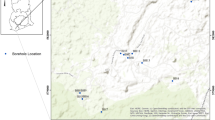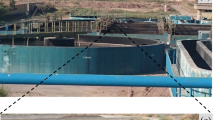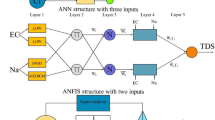Abstract
Prediction of biochemical oxygen demand (BOD) as the main pollution indicators of organic pollution in freshwater resources is necessary. In the present work, a hybrid wavelet-genetic programming (WGP) method was implemented to improve prediction of BOD. The Shannon entropy was used to identify the optimal input combinations of WGP. In addition, an investigation was done to find which functions of wavelet and decomposition levels have better results in conjunction with genetic programming (GP). For comparison of WGP efficiency, five machine learning methods consisting of WANN (wavelet-artificial neural network), ANN (artificial neural network), GP, DT (decision tree) and BN (Bayesian network) were considered. Experiments on wavelet-processed data revealed that the best results were obtained when the models WGP and WANN were calibrated at three levels of decomposition using the Dmey mother wavelet function. The WGP model created rational forecasts for the peak BOD values. The results show that the use of Shannon entropy is suitable for determining the optimal composition of inputs to machine learning methods. Comparison of the results indicate that the WGP model is superior to the GP, ANN, DT, BN and WANN models based on data from the Varian Hotel and Dam Input stations.














Similar content being viewed by others
References
Abdellatif, M., Atherton, W., & Alkhaddar, R. (2013). A hybrid generalized linear and Levenberg–Marquardt artificial neural network approach for downscaling future rainfall in North Western England. Hydrology Research, 44(6), 1084–1101.
Alimoradi, S., Faraj, R., & Torabian, A. (2018). Effects of residual aluminum on hybrid membrane bioreactor (Coagulation-MBR) performance, treating dairy wastewater. Chemical Engineering and Processing—Process Intensification., 133, 320–324.
Altun, H., Bilgil, A., & Fidan, B. C. (2007). Treatment of multi-dimensional data to enhance neural network estimators in regression problems. Expert Systems with Applications, 32(2), 599–605.
Azizi Jalilian, M., Danehkar, A., & Fami, H. S. A. (2012). Determination of indicators and standards for tourism impacts in protected Karaj River, Iran. Tourism Management, 33, 61–63.
Banzhaf, W., Nordin, P., Keller, R., & Francone, F. D. (1998). Genetic programming—An introduction on the automatic evolution of computer programs and its application. Heidelberg, San Francisco: dpunkt/Morgan Kaufmann.
Bayram, A., Kankal, M., & Önsoy, H. (2012). Estimation of suspended sediment concentration from turbidity measurements using artificial neural networks. Environmental Monitoring and Assessment, 184, 4355–4365.
Choubin, B., Solaimani, K., Habibnejad Roshan, M., & Malekian, A. (2017). Watershed classification by remote sensing indices: A fuzzy c-means clustering approach. Journal of Mountain Science, 14, 2053–2063.
Danandeh Mehr, A., Kahya, E., Bagheri, F., & Deliktas, E. (2013a). Successive-station monthly streamflow prediction using neuro wavelet technique. Earth Science Information. https://doi.org/10.1007/s12145-013-0141-3.
Danandeh Mehr, A., Kahya, E., & Olyaie, E. (2013b). Streamflow prediction using linear genetic programming in comparison with a neuro-wavelet technique. Journal of Hydrology, 505, 240–249.
Danandeh Mehr, A., Kahya, E., & Ozger, M. (2014). A gene–wavelet model for long lead time drought forecasting. Journal of Hydrology, 517, 691–699.
Dogan, E., Ates, A., Yilmaz, E. C., & Erem, B. (2008). Application of artificial neural networks to estimate wastewater treatment plant inlet biochemical oxygen demand. Environmental Progress & Sustainable Energy, 27, 439–446.
Dogan, E., Sengorur, B., & Koklu, R. (2009). Modeling biological oxygen demand of the Melen River in Turkey using an artificial neural network technique. Journal of Environmental Management, 90, 1229–1235.
Dolling, O. R., & Varas, E. A. (2002). Artificial neural networks for stream flow prediction. Journal of Hydraulic Research, 40(5), 547–554.
Evrendilek, F., & Karakaya, M. (2014). Monitoring diel dissolved oxygen dynamics through integrating wavelet denoising and temporal neural networks. Environmental Monitoring and Assessment, 186, 1583–1591.
Goldberg, D. E. (1989). Genetic algorithms in search optimisation and machine learning. Boston: Addison-Wesley.
Hamed, M. M., Khalafallah, M. G., & Hassanien, E. A. (2004). Prediction of wastewater treatment plant performance using artificial neural network. Environmental Modeling & Software, 19, 919–928.
Han, H., Chen, Q., & Qiao, J. (2011). An efficient self-organizing RBF neural network for water quality prediction. Neural Networks, 24, 1–9.
Khani, S., & Rajaee, T. (2017). Modeling of dissolved oxygen concentration and its hysteresis behavior in rivers using wavelet transform based hybrid models. CLEAN–Soil, Air, Water, 45, 2.
Kisi, O. (2005). Suspended sediment estimation using neuro-fuzzy and neural network approaches. Hydrological Sciences Journal, 50(4), 683–696.
Kisi, O. (2009). Wavelet regression model as an alternative to neural networks for monthly stream flow forecasting. Hydrological Processes, 23, 3583–3597.
Kisi, O. (2010). Daily suspended sediment estimation using neuro-wavelet models. International Journal of Earth Sciences, 99, 1471–1482.
Kisi, O., & Cimen, M. (2012). Precipitation forecasting by using wavelet-support vector machine conjunction model. Engineering Applications of Artificial Intelligence, 25(4), 783–792.
Kisi, O., Shiri, J., & Nikoofar, B. (2012). Forecasting daily lake levels using artificial intelligence approaches. Computers & Geosciences, 41, 169–180.
Koza, J. R. (1992). Genetic programming: On the programming of computers by means of natural selection. Cambridge, MA: MIT Press.
Li, F., Li, D., Wei, Y., Ma, D., & Ding, Q. (2010). Dissolved oxygen prediction in apostichopus japonicus aquaculture ponds by BP neural network and AR model. Sensor Letters, 8(1), 95–101.
Liao, H., & Sun, W. (2010). Forecasting and evaluating water quality of Chao Lake based on an improved decision tree method. Procedia Environmental Sciences, 2, 970–979.
Liu, Q.-J., Shi, Z.-H., Fang, N.-F., Zhu, H.-D., & Ai, L. (2013). Modeling the daily suspended sediment concentration in a hyper concentrated river on the Loess Plateau, China, using the Wavelet–ANN approach. Geomorphology, 186, 181–190.
Masters, T. (1993). Practical neural network recipes in C++. San Diego, CA: Academic Press.
Melesse, A. M., Ahmad, S., McClain, M. E., Wang, X., & Lim, Y. H. (2011). Suspended sediment load prediction of river systems: An artificial neural network approach. Agricultural Water Management, 98, 855–866.
Mjalli, F. S., Al-Asheh, S., & Alfadala, H. E. (2007). Use of artificial neural network black-box modeling for the prediction of wastewater treatment plants performance. Journal of Environmental Management, 83(3), 329–338.
Muttil, N., & Chau, K. W. (2006). Neural network and genetic programming for modelling coastal algal blooms. International Journal of Environment and Pollution, 28, 223–238.
Nourani, V., & Andalib, G. (2015). Daily and monthly suspended sediment load predictions using wavelet based artificial intelligence approaches. Journal of Mountain Science, 12(1), 85–100.
Olyaie, E., Banejad, H., & Chau, K. (2015). A comparison of various artificial intelligence approaches performance for estimating suspended sediment load of river systems: A case study in United States. Environmental Monitoring and Assessment, 187, 189.
Osowski, S., & Garanty, K. (2007). Forecasting of the daily mete-orological pollution using wavelets and support vector machine. Engineering Applications of Artificial Intelligence, 20, 745–755.
Palani, S., Liong, S., & Tkalich, P. (2009). Development of a neural network for dissolved oxygen in seawater, Indian. Journal of Marine Sciences, 38(2), 151–159.
Partal, T., & Cigizoglu, H. K. (2008). Estimation and forecasting of daily suspended sediment data using wavelet neural networks. Journal of Hydrology, 358, 317–331.
Paschalidou, A. K., Karakitsios, S., Kleanthous, S., & Kassomenos, P. A. (2011). Forecasting hourly PM10 concentration in Cyprus through artificial neural networks and multiple regression models: Implications to local environmental management. Environmental Science and Pollution Research, 18, 316–327.
Prechelt, L. (1998). Early stopping—But when? Lecture Notes in Computer Science, 1524, 55–69.
Quinlan, J. R. (1993). C4.5: Programs for machine learning. San Mateo, CA: Morgan Kaufmann.
RahimiKhoob, A. (2008). Artificial neural network estimation of reference evapotranspiration from pan evaporation in a semi-arid environment. Irrigation Science, 27(1), 35–39.
Rajaee, T. (2010). Wavelet and neuro-fuzzy conjunction approach for suspended sediment prediction. Clean–Soli, Air, Water, 38(3), 275–286.
Rajaee, T. (2011). Wavelet and ANN combination model for prediction of daily suspended sediment load in Rivers. Science of the Total Environment, 409, 2917–2928.
Rajaee, T., & Boroumand, A. (2015). Forecasting of chlorophyll-a concentrations in South San Francisco Bay using five different models. Applied Ocean Research, 53, 208–217.
Rajaee, T., Ebrahimi, H., & Nourani, V. (2018a). A review of the artificial intelligence methods in groundwater 1597 level modeling. Journal of Hydrology, 572, 336–351.
Rajaee, T., & Jafari, H. (2018). Utilization of WGEP and WDT models by wavelet denoising to predict water quality parameters in Rivers. Journal of Hydrological Engineering, 23, 12.
Rajaee, T., Khani, S., & Ravansalar, M. (2020). Artificial intelligence-based single and hybrid models for prediction of water quality in rivers: A review. Chemometrics and Intelligent Laboratory Systems. https://doi.org/10.1016/j.chemolab.2020.103978.
Rajaee, T., Mirbagheri, S. A., Zounemat-Kermani, M., & Nourani, V. (2009). Daily suspended sediment concentration simulation using ANN and neuro-fuzzy models. Science of the Total Environment, 407, 16–27.
Rajaee, T., Ravansalar, M., Adamowski, J., & Deo, R. (2018b). A new approach to predict daily pH in rivers based on the “à trous” redundant wavelet transform algorithm. Water, Air, and Soil pollution, 229, 85–93.
Rajaee, T., & Shahabi, A. (2015). Evaluation of wavelet-GEP and wavelet-ANN hybrid models for prediction of total nitrogen concentration in coastal marine waters. Arabian Journal of Geosciences, 9, 176.
Ramezani, M., Noori, R., Hooshyaripor, F., Deng, D., & Sarang, A. (2019). Numerical modelling-based comparison of longitudinal dispersion coefficient formulas for solute transport in rivers. Hydrological Sciences Journal. https://doi.org/10.1080/02626667.2019.1605240.
Ravansalar, M., & Rajaee, T. (2015). Evaluation of wavelet performance via an ANN-based electrical conductivity prediction model. Environmental Monitoring Assessment, 187, 366.
Ravansalar, M., Rajaee, T., & Ergil, M. (2015). Prediction of dissolved oxygen in River Calder by noise elimination time series using wavelet transform. Journal of Experimental & Theoretical Artificial Intelligence. https://doi.org/10.1080/0952813X.2015.1042531.
Ravansalar, M., Rajaee, T., & Zounemat-Kermani, M. (2016). A wavelet-linear genetic programming model for sodium (Na +) concentration forecasting in rivers. Journal of Hydrology. https://doi.org/10.1016/j.jhydrol.2016.03.062.
Sahoo, G. B., Ray, C., Mehnert, E., & Keefer, D. A. (2006). Application of artificial neural networks to assess pesticide contamination in shallow groundwater. Science of the Total Environment, 367, 234–251.
Schmitz, J. E., Zemp, R. J., & Mendes, M. J. (2006). Artificial neural networks for the solution of the phase stability problem. Fluid Phase Equilibria, 245(1), 83–87.
Shannon, C. E. (1948). A mathematical theory of communications, I and II. The Bell System Technical Journal, 27, 379–423.
Shiri, J., Kim, S., & Kisi, O. (2014). Estimation of daily dew point temperature using genetic programming and neural networks approaches. Hydrology Research, 45(2), 165–181.
Shiri, J., & Kisi, O. (2011). Comparison of genetic programming with neuro-fuzzy systems for predicting short-term water table depth fluctuations. Computers & Geosciences, 37(10), 1692–1701.
Singh, K. P., Basant, A., Malik, A., & Jain, G. (2009). Artificial neural network modeling of the River water quality—A case study. Ecological Modelling, 220(6), 888–895.
Siwek, K., & Osowski, K. (2012). Improving the accuracy of prediction of PM10 pollution by the wavelet transformation and an ensemble of neural predictors. Engineering Applications of Artificial Intelligence, 25, 1246–1258.
Whigham, P. A., & Crapper, P. F. (2001). Modeling rainfall runoff using genetic programming. Mathematical and Computer Modelling, 33, 707–721.
Xu, L., & Liu, S. (2013). Study of short-term water quality prediction model based on wavelet neural network. Mathematical and Computer Modeling, 58, 807–813.
Yang, C., & Nio, S. (1985). The estimation of palaeo hydrodynamic processes from sub tidal deposits using time series analysis methods. Sedimentology, 32, 41–57.
Zounemat-kermani, M., Kisi, O., & Rajaee, T. (2013). Performance of radial basis and LM-feed forward artificial neural networks for predicting daily watershed runoff. Applied Soft Computing, 13, 4633–4644.
Zounemat-Kermani, M., & Scholz, M. (2014). Modeling of dissolved oxygen applying stepwise regression and a template-based fuzzy logic system. Journal of Environmental Engineering, 140(1), 69–76.
Author information
Authors and Affiliations
Corresponding author
Rights and permissions
About this article
Cite this article
Jafari, H., Rajaee, T. & Kisi, O. Improved Water Quality Prediction with Hybrid Wavelet-Genetic Programming Model and Shannon Entropy. Nat Resour Res 29, 3819–3840 (2020). https://doi.org/10.1007/s11053-020-09702-7
Received:
Accepted:
Published:
Issue Date:
DOI: https://doi.org/10.1007/s11053-020-09702-7




